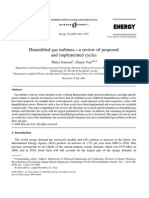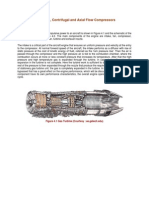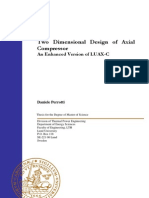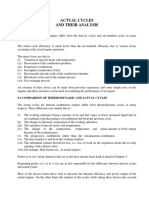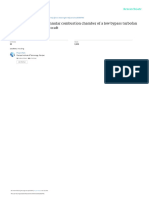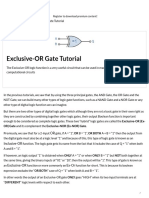The Design of An Annular Combustion Chamber: October 2017
The Design of An Annular Combustion Chamber: October 2017
Uploaded by
ko koCopyright:
Available Formats
The Design of An Annular Combustion Chamber: October 2017
The Design of An Annular Combustion Chamber: October 2017
Uploaded by
ko koOriginal Title
Copyright
Available Formats
Share this document
Did you find this document useful?
Is this content inappropriate?
Copyright:
Available Formats
The Design of An Annular Combustion Chamber: October 2017
The Design of An Annular Combustion Chamber: October 2017
Uploaded by
ko koCopyright:
Available Formats
See discussions, stats, and author profiles for this publication at: https://www.researchgate.
net/publication/323446276
The design of an annular combustion chamber
Conference Paper · October 2017
CITATION READS
1 10,295
4 authors:
Marius Enache Andreea Cristina Petcu
National Research and Development Institute for Gas Turbines National Research and Development Institute for Gas Turbines
13 PUBLICATIONS 2 CITATIONS 30 PUBLICATIONS 69 CITATIONS
SEE PROFILE SEE PROFILE
Razvan Carlanescu Florean Florin Gabriel
National Research and Development Institute for Gas Turbines National Research and Development Institute for Gas Turbines
26 PUBLICATIONS 33 CITATIONS 28 PUBLICATIONS 41 CITATIONS
SEE PROFILE SEE PROFILE
Some of the authors of this publication are also working on these related projects:
LEMLES View project
Numerical modeling View project
All content following this page was uploaded by Marius Enache on 05 March 2018.
The user has requested enhancement of the downloaded file.
Aerospace Europe
6th CEAS Conference
The design of an annular combustion chamber
Marius Enache
Junior Researcher
National Research and Development Institute for Gas Turbines COMOTI
220 D Iuliu Maniu Bd., sector 6, cod 061126, OP 76, CP174, Bucharest, Romania
marius.enache@comoti.ro
Andreea Mangra
Scientific Researcher
Razvan Carlanescu
Scientific Researcher
Florin Florean
Scientific Researcher
ABSTRACT
The design of an annular combustion chamber for a micro gas turbine engine is presented in
this paper. The combustion chamber is designed for using biogas as fuel. It is designed based on the
constant pressure, enthalpy addition process. The present methodology deals with the computation of
the initial design parameters and arriving at optimized values. Then the dimensions of the combustor
are calculated based on different empirical formulas. The air mass flow is then distributed across the
zones of the combustor. The cooling requirement is met using the cooling holes. The whole
combustion chamber is modeled using Catia V5. The model is then analyzed using various parameters
at various stages and levels to determine the optimized design. The aerodynamic flow characteristics
are numerically simulated by means of the ANSYS CFX software. The air-fuel mixture, combustion-
turbulence, the thermal and cooling analysis is carried out. The results are then presented in image
outputs and graphs.
KEYWORDS: Aerodynamic design; annular combustion chamber; CFD (computational fluid
dynamics) analysis.
NOMENCLATURE
LATIN GREEK
S-section area [𝑚𝑚2 ]; 𝛼-excess air;
T-temperature [K]; 𝑘𝑔
𝜌-density [ 3 ];
𝑚̇-mass flow [kg/s]; 𝑚
𝜙-hole diameter [mm];
v-velocity [m/s];
r-radius [mm];
1. INTRODUCTION
The scope of this article is to present a design methodology for a combustor which will be
part of a micro gas turbine for a 350 kW cogeneration power plant which works after a Brayton
recovery cycle. The compressor and the turbine are the single-stage centrifugal type. The combustion
chamber is of annular type. The micro gas turbine is designed to function using biogas as fuel.
The combustion chamber, or combustor, of a gas turbine, is the device that receives the
pressurized air from the compressor and promotes its mixture with the fuel in order to release the
heat energy through a combustion reaction. Gas turbines work with a high excess of air, usually out
of the flammability limits, and so a flame tube, or liner, is used to improve the distribution of air
CEAS 2017 paper no. 810 Page | 1
The design of an annular combustion chamber
M. Enache, A. Mangra,R.Carlanescu,F.Florean Copyright © 2017 by author(s)
Aerospace Europe
6th CEAS Conference
through the reactor. Basically, the liner divides the combustion chamber into three zones: primary
zone, secondary or intermediate zone and dilution zone. At the primary zone, a recirculation zone
shall be developed to ensure the stability of the flame. The main function of the primary zone is to
anchor the flame and provide sufficient time, temperature, and turbulence to achieve essentially
complete combustion of the incoming fuel-air mixture. The primary-zone a portion of the hot
combustion gases are entrained and recirculated in order to provide continuous ignition to the
incoming air and fuel. If the primary-zone temperature is higher than around 2000 K, dissociation
reactions will result in the appearance of significant concentrations of carbon monoxide (CO) and
hydrogen (H2) in the efflux gases. Should these gases pass directly to the dilution zone and be rapidly
cooled by the addition of massive amounts of air, the gas composition would be “frozen,” and CO,
which is both a pollutant and a source of combustion inefficiency, would be discharged from the
combustor unburned. Thus in the secondary zone, the temperature is dropped to an intermediate
level by the addition of small amounts of air encourages the burnout of soot and allows the
combustion of CO and any other unburned hydrocarbons (UHC) to proceed to completion. The role of
the dilution zone is to admit the air remaining after the combustion and wall-cooling requirements
have been met and to provide an outlet stream with a temperature distribution that is acceptable to
the turbine.
Combustion chamber design methodologies have been proposed by Lefebvre [1] and
Melconian & Modak [2]. However, these methodologies have been developed for the design of
aeronautical and large industrial gas turbine combustors. These methods have been successfully
used to design combustion chambers [3, 5, 6] and there has even been developed software in which
these methods have been implemented [4].
Mohammad and Jeng [7] have developed a computer code for annular combustor design.
The design algorithm employs empirical and semi-empirical models which include diffuser section
design, air distribution computations, combustor sizing, fuel nozzle design, axial swirler design, heat
transfer calculations (with/without cooling, thermal barrier coating) and dilution holes design.
Conrado et al [8] present a methodology for gas turbine combustor basic design. Criteria for
selecting a suitable combustor configuration are examined followed by design calculations for the
dimensions of the casing, the liner, the diffuser, and the swirler. Calculations of gas temperature in
the various zones of the combustor and liner wall temperatures in the presence of film cooling are
performed along with design calculations for the dimensions of the air admission holes. A
computational program was developed based on the sequence of equations discussed in the paper.
In [9] is presented a combustion chamber design methodology using a software developed
for this purpose. The software developed calculates the dimension for a straight through tubular
combustion chamber that operates with gaseous fuel. This software allows visualizing the main
aerodynamics parameters that are involved in the project of a simple combustor. The equations
involved on the calculus of the program are based on the methodology developed by Lefebvre.
2. DESIGN METHODOLOGY
The first step in designing the combustor was the determination of the excess air and fuel
mass flow starting from the input data presented in Table 1 and Table 2.
Table 1: Parameters of the gas turbine cycle
Parameter Value Units
Compression ratio 5:1
Intake temperature of Turbine (T3) 1173 K
Output temperature of Compressor (T2) 750 K
Air Mass flow 2.6 kg/s
Efficiency of air compressor 80 %
Efficiency of turbine 85 %
CEAS 2017 paper no. 810
The design of an annular combustion chamber Page | 2
M. Enache, A. Mangra,R.Carlanescu,F.Florean Copyright © 2017 by author(s)
Aerospace Europe
6th CEAS Conference
Table 2: Chemical composition of the fuel
Volume percent (%) Density (kg/Nm3)
CH4 50 0,656
CO2 45 1.842
N2 3 1.165
O2 0.8 1.331
NH4 0.6 0.73
H2 0.2 0.089
CO 0.2 1.14
H2S 0.2 1.434
The density of the biogas, according to the chemical composition in Table 2 is 1.21 kg/Nm3.
The low calorific power of the biogas was determined using Eq. 1:
𝐻𝑖 = 12720 ∙ (𝐶𝑂) + 10800 ∙ (𝐻2 ) + 35910 ∙ (𝐶𝐻4 ) + 23400 ∙ (𝐻2 𝑆), 𝑘𝐽/𝑁𝑚3 (1)
where (CO), (H2), (CH4) and (H2S) represent the volume percent for each component of the biogas
[10]. Thus a low calorific power of 18048 kJ/Nm3 was obtained. Or taking into account the biogas
density, a low calorific power of 14889 kJ/kg.
Eq. 2 was used for determining the theoretical quantity of oxygen necessary for complete
combustion [10]:
3
𝑛 𝑚𝑁
𝑂𝑚𝑖𝑛 = 0,5 ∙ [(𝐶𝑂) + (𝐻2 )] + ∑(𝑚 + ) ∙ (𝐶𝑚𝐻𝑛) + 1,5 ∙ (𝐻2𝑆) − (𝑂2) [ 3 ] (2)
4 𝑚𝑁
where (CO), (H2), (CmHn), (H2S) and (O2) represent the volumetric participations for each component
of the biogas [10]. Using Eq. 2, for m=1 and n=4, the following value was obtained: Omin=0.997.
The theoretical quantity of air necessary for complete combustion was determined using Eq. 3:
𝑂𝑚𝑖𝑛 (3)
𝐿𝑚𝑖𝑛 =
0,21
obtaining the value: 4.74.
The excess of air was determined using Eq. 4:
𝐻𝑖 − 𝑐𝑝𝑔 ∙ 𝑇3
𝛼=
𝑐𝑝𝑔 ∙ 𝑇3 ∙ 𝐿𝑚𝑖𝑛 − 𝑐𝑝𝑎 ∙ 𝑇2 ∙ 𝐿𝑚𝑖𝑛 (4)
where cpa represents the specific heat of air and cpg represents the specific heat of exhaust gases [9].
For T2=750 K and T3 = 1173 K an air excess of 5.37 was obtained.
For an air mass flow of 2.6 kg/s and using Eq. 5:
𝑚𝑎 𝑘𝑔 (5)
𝑚𝑐 = [ ]
𝛼 ∙ 𝐿𝑚𝑖𝑛 𝑠
a fuel mass flow of 0.092453 kg/s was obtained.
The next step in designing the combustor was to determine the excess of air and the
temperature alongside the liner.
For this purpose the combustor was divided into three regions:
1. The fuel injectors region;
2. The primary zone;
3. The dilution zone;
CEAS 2017 paper no. 810 Page | 3
The design of an annular combustion chamber
M. Enache, A. Mangra,R.Carlanescu,F.Florean Copyright © 2017 by author(s)
Aerospace Europe
6th CEAS Conference
Figure 1: The three regions of the combustion chamber
Taking into consideration the information presented in the specialty literature [1], it was
considered that 10% of the total air mass flow enters the fuel in the injectors region, 18% of the total
air mass flow enters in the primary zone and the rest of 72% enters the dilution zone.
Table 3: Parameters resulted for the three regions of the combustion chamber
Regions 1 2 3
ma(kg/s) 0.260 0.468 1.872
𝛼 (excess air) 0.593 1.661 5.932
The temperature along the combustion chamber was determined using Eq. 6:
efic H i Lmin T2 H i
T [K] (6)
(1 Lmin ) c p _ g
where efic represents the combustion efficiency. Its values were taken according to [11]. As expected
the temperature maximum value is obtained in the primary zone.
Figure 2: Temperature distribution
The final step in the design process was to determine the velocities outside and inside the fire
tube and the liner holes diameters based on the jet penetration.
The pressure at the compressor’s exit is 500000 Pa (p2). Since the distance from the
compressor exit to the combustor entrance is considerable due to the micro gas turbine constructive
solution, it was considered that the air pressure at the combustor entrance is 475000 Pa.
The velocities outside and inside the fire tube have been calculated using Eq. 7:
𝑚̇
𝑣 = 𝜌∙𝑆 [𝑚𝑠] (7)
where S represents the section area.
CEAS 2017 paper no. 810
The design of an annular combustion chamber Page | 4
M. Enache, A. Mangra,R.Carlanescu,F.Florean Copyright © 2017 by author(s)
Aerospace Europe
6th CEAS Conference
Table 4: Repartition of velocity exterior of the fire tube
Exterior air annular section
rext (mm) rint (mm) mc (kg/s) ma (kg/s)
322 311 0.092453 2.6
S=21863.82 mm 2
Interior air annular section
rext (mm) rint (mm) mc (kg/s) ma (kg/s)
261 250 0.092453 2.6
S=17649.94 mm 2
Region 1 2 3
Pressure loss (dp%) 1 2 3
Pressure (Pa) 467775 463050 458325
Air density (ρa) 2.1797 2.1577 2.1357
Mass flow (kg/s) 2.6 2.34 1.872
v(m/s) 30.1862 27.4448 22.1822
Table 5: Repartition of velocity interior of the fire tube
rext (mm) rint (mm) mc (kg/s) ma (kg/s)
311 261 0.092453 2.6
S=89804 mm 2
Region 1 2 3
Pressure loss (dp%) 1.25 2.25 3.25
Pressure (Pa) 466593.75 461868.8 457143.8
Fuel density (ρg) 0.9359 0.8344 1.3338
Mass flow (kg/s) 0.3524 0.8204 2.6924
v(m/s) 4.1934 10.9490 22.4776
The jet penetration was calculated using Eq. 8 [11]:
𝑉𝑎
𝐻𝑗𝑖 = 3.1 ∙ 𝜙 ∙ (0.3 + 0.415 ∙ ) (8)
𝑉𝑔
Table 6: Jet penetration
Region 1 2 3
Air Velocity(𝑉𝑎 ) 30.18 27.44 22.18
Fuel Velocity(𝑉𝑔) 4.19 10.94 22.47
Hole diameter 𝜙 (mm) 2.5 5 6.5
Jet penetration (𝐻𝑗𝑖 ) 25.49 20.78 14.29
Based on the calculations presented above a first version of the combustor geometry,
presented in Fig. 3, has resulted.
CEAS 2017 paper no. 810 Page | 5
The design of an annular combustion chamber
M. Enache, A. Mangra,R.Carlanescu,F.Florean Copyright © 2017 by author(s)
Aerospace Europe
6th CEAS Conference
Figure 3: Fire tube
Figure 4: Combustion chamber assembly
3. Three-dimensional numerical simulation results
In order to obtain quicker results due computing limitation, the model was simplified into a
22.5-degree cut section for the combustor. The computational aerodynamic analysis is carried out to
validate theoretical results and to obtain a detailed preview of the outcome design.
The numerical simulations were carried out using ANSYS CFX software. An RANS approach
was used with an unstructured type mesh has been generated for the computational domain and with
the Domain Motion Stationary. Number of Tetrahedral Elements: 8231719.
The following boundary conditions were used. At air inlet, there were imposed the air mass
flow and temperature, at fuel inlet there were imposed the fuel mass flow and temperature and at
the outlet, the pressure was imposed.
The Eddy Dissipation combustion model was used, in combination with the K-epsilon
turbulence model. This model was chosen because it allows accurate simulation of the heat release
and the distribution of the main chemical species.
The velocity distribution presented in Fig. 5 shows high velocity in the central region. Jet
penetration is very strong, thus the created turbulence will affect combustion process.
CEAS 2017 paper no. 810
The design of an annular combustion chamber Page | 6
M. Enache, A. Mangra,R.Carlanescu,F.Florean Copyright © 2017 by author(s)
Aerospace Europe
6th CEAS Conference
Figure 5: Velocity distribution
From Fig. 6 it can be observed that the flame temperature presents high values mainly near
the combustor’s walls. This is in good correlation with the velocity profile presented in Fig. 5. The
high-velocity values from the central region of the fire tube make difficult the mixing of the air and
fuel in the primary region.
Figure 6: Total temperature distribution
In Fig. 7 are presented 4 temperature isosurfaces inside the fire tube (red=2200 K,
orange=2000 K, yellow=1800 K, green 1500 K). As it was observed before, the high flame
temperatures are developing near the walls. This is not a good sign. It can lead to serious damage to
the fire tube. It also can be seen that the flame has a very irregular structure.
CEAS 2017 paper no. 810 Page | 7
The design of an annular combustion chamber
M. Enache, A. Mangra,R.Carlanescu,F.Florean Copyright © 2017 by author(s)
Aerospace Europe
6th CEAS Conference
Figure 7: Total temperature Isosurface distribution
The average temperature at the exit of the combustor was 1150K. Even though this
temperature value is very close to the one imposed in Table 1, based on the results obtained so far it
was concluded that same changes have to be done to the combustor geometry.
A deflector was added to the original geometry in order to concentrate the flow in the central
region of the fire tube and to prevent flame adhesion to the walls of the combustor. The
improvement can be observed in Fig. 8 and Fig. 9. The flow velocity has diminished and the flame is
concentrated in the center of the fire tube.
Figure 8: Velocity distribution
CEAS 2017 paper no. 810
The design of an annular combustion chamber Page | 8
M. Enache, A. Mangra,R.Carlanescu,F.Florean Copyright © 2017 by author(s)
Aerospace Europe
6th CEAS Conference
Figure 9: Total temperature distribution
In Fig. 10 the temperature distribution along the fire tube is presented. As it can be seen, the
temperature rise up to 1400 K in the region of the injectors, afterward reaching a maximum of 2100
K in the primary zone. After that, the addition of air leads to a decrease of the flame temperature.
Figure 10: Total temperature distribution
Form Fig. 11 it can be seen that the flame has a uniform structure and the flame does not
exceed the fire tube length. Thus it won’t affect the turbine.
Figure 11: Total temperature Isosurface distribution
The average outlet temperature is of 1180 K, being close to the required value.
CEAS 2017 paper no. 810 Page | 9
The design of an annular combustion chamber
M. Enache, A. Mangra,R.Carlanescu,F.Florean Copyright © 2017 by author(s)
Aerospace Europe
6th CEAS Conference
4.Conclusions
The complete annular combustor design using just the initial design parameters has been
discussed in this paper. This is a design methodology which can be used for the preliminary design.
The transparent and detailed approach is focused on reducing design time and complexity. This gives
an overall advantage in total design time and prototype building. Using the methodology, a practical
design is presented. The obtained values are used for modeling and further simplified for analysis.
The analysis was also carried out with higher accuracy using the combustion-turbulence interaction
model and the results show that the optimum gas exit temperature was obtained for the present
design. The design was successfully calculated and modeled.
REFERENCES
1. A.H. Lefebvre, D.R. Ballal, 2010; Gas Turbine Combustion 3rd edition, CRC Press Taylor & Francis
Group
2. Melconian, J.W. Modak; 1985; Combustors Design, in: Sawyer's Gas Turbine Engineering
Handbook: Theory & Design, Vol. 1, Turbomachinery International Publications, Connecticut.
3. C. P. Mark, A. Selwyn; 2016; Design and analysis of annular combustion chamber of a low bypass
turbofan engine in a jet trainer aircraft, Propulsion and power research; vol 5 (2); pp 97-107
4. R.E.P. Silva, P.T. Lacava; 2013; Preliminary design of a combustion chamber for micro turbine
based in automotive turbocharger, Proceedings of the 22nd COBEM; pp. 412–422,
5. S.A. Hashim; 2013 Design and fabrication of an annular combustion chamber for the micro gas
turbine engine applications, IJERT, vol 2
6. N. Pegemanyfar, M. Pfitzner; 2006; Development of a combustion chamber design methodology
and automation of the design process, 25 th International Congress of the Aeronautical Sciences,
Hamburg, Germany
7. B.S. Mohammad, S.M. Jeng; 2009; Design procedures and a developed computer code for
preliminary single annular combustor design, 45 th AIAA Joint Propulsion Conference & Exhibit,
Denver, Colorado
8. A.C. Conrado, P.T. Lacava, A.C.P. Filho, M.D.S. Sanches; 2004; Basic design principles for gas
turbine combustor, in: Proceedings of the 10th ENCIT, paper no.0316.
9. L.J. Mendes Neto, A. Paramonov, E.E. Silva Lora, M.A. Rosa do Nascimento, Preliminary design of
micro gas turbine combustion chamber for biomass gas;
http://seeds.usp.br/pir/arquivos/congressos/CLAGTEE2003/Papers/RNCSEP%20B-103.pdf
10. B. Popa, C. Vintila, 1973; Termotehnica, masini si instalatii termice, Ed. Didactica si pedagogica,
Bucuresti
11. V. Pimsner, C.A. Vasilescu, G.A. Radulescu, 1964; Energetica turbomotoarelor cu ardere interna,
Editura Academiei Republicii Populare România, Bucureşti
CEAS 2017 paper no. 810
The design of an annular combustion chamber Page | 10
M. Enache, A. Mangra,R.Carlanescu,F.Florean Copyright © 2017 by author(s)
View publication stats
You might also like
- The Game Producers Handbook PDFDocument353 pagesThe Game Producers Handbook PDFKev G.100% (1)
- Emsland Germany Ka26 CCPP Project DatasheetDocument6 pagesEmsland Germany Ka26 CCPP Project DatasheetNihed KilaniNo ratings yet
- Basic Design Principles For Gas Turbine CombustorDocument12 pagesBasic Design Principles For Gas Turbine CombustorLeela PrasadNo ratings yet
- The Effects of Two Shaft Gas Turbine Operating Conditions On The Overall PerformanceDocument16 pagesThe Effects of Two Shaft Gas Turbine Operating Conditions On The Overall PerformanceAhmad Mohammad Abdul-Aziz100% (1)
- L4-Gas Turbine Systems SSRDocument18 pagesL4-Gas Turbine Systems SSRTarun Malviya100% (1)
- Modeling of Compressor Blade Behavior Under Tip Rubbing ConditionsDocument21 pagesModeling of Compressor Blade Behavior Under Tip Rubbing Conditionsamir moniriNo ratings yet
- APD Dynamic StressesDocument11 pagesAPD Dynamic StressesadehriyaNo ratings yet
- DETC2009-86080: The Use of Interference Diagrams To Avoid Impeller Resonance: An Application To Igv DesignDocument8 pagesDETC2009-86080: The Use of Interference Diagrams To Avoid Impeller Resonance: An Application To Igv DesignRajesh KachrooNo ratings yet
- CREEP AND FATIGUE FAILURE ANALYSIS OF TURBINE BLADE REPORT-2 (Final)Document28 pagesCREEP AND FATIGUE FAILURE ANALYSIS OF TURBINE BLADE REPORT-2 (Final)akshithaNo ratings yet
- Analysis of Turbo Combustor: A Device To Anchor The Flame . The Cause of Major Component of Running Cost .Document14 pagesAnalysis of Turbo Combustor: A Device To Anchor The Flame . The Cause of Major Component of Running Cost .nazeemlngNo ratings yet
- Kurzke Turbine Map ExtensionpdfDocument14 pagesKurzke Turbine Map ExtensionpdfzzzNo ratings yet
- Humidified Gas Turbines, by EderDocument66 pagesHumidified Gas Turbines, by EderDomingo Pinto100% (1)
- Gas Turbine CombustionDocument9 pagesGas Turbine Combustionvarun kumarNo ratings yet
- Design and Structural Thermal Analysis of Gas Turbine Rotor Blade With Radial Holes Using SolidworksDocument5 pagesDesign and Structural Thermal Analysis of Gas Turbine Rotor Blade With Radial Holes Using SolidworksEditor IJTSRDNo ratings yet
- Lec. On Materials of Gas Turbine ComponentsDocument47 pagesLec. On Materials of Gas Turbine Componentspartha6789100% (2)
- Design, Manufacturing and Operation of A Small Turbojet-Engine For Research PurposesDocument15 pagesDesign, Manufacturing and Operation of A Small Turbojet-Engine For Research PurposeskrishnaNo ratings yet
- Lefebvre 1995Document38 pagesLefebvre 1995stepanovatvNo ratings yet
- Enhanced Emission Prediction Modeling and Analysis For Conceptual DesignDocument90 pagesEnhanced Emission Prediction Modeling and Analysis For Conceptual Designsb aliNo ratings yet
- GTU AERO445 Turbomachinery WEEK1 NotesDocument39 pagesGTU AERO445 Turbomachinery WEEK1 NotesVainamoinen MiddlefingerNo ratings yet
- I A G T C: Ndustrial Pplication OF AS Urbines OmmitteeDocument13 pagesI A G T C: Ndustrial Pplication OF AS Urbines Ommittee'Izzad Afif100% (1)
- Demonstration of Model-Based, Off-Line Performance Analysis On A Gas Turbine Air CompressorDocument7 pagesDemonstration of Model-Based, Off-Line Performance Analysis On A Gas Turbine Air Compressorherysyam1980No ratings yet
- 1st Place Undergraduate Team-The University of KansasDocument98 pages1st Place Undergraduate Team-The University of KansasKimberlly Costa Carvalho100% (2)
- Gas Turbine System & PropulsionDocument35 pagesGas Turbine System & PropulsionnaveedsidhuNo ratings yet
- GT2011 45373Document8 pagesGT2011 45373Александр ТумановNo ratings yet
- Compressor Turbine MatchingDocument2 pagesCompressor Turbine MatchingSumesh SpankoNo ratings yet
- Came 1998Document18 pagesCame 1998pradeepsmart1988100% (1)
- ME8792 PPE by WWW - Learnengineering.inDocument136 pagesME8792 PPE by WWW - Learnengineering.inKarthi BENo ratings yet
- MSI Centrifugal Impeller Structural Resonance PDFDocument9 pagesMSI Centrifugal Impeller Structural Resonance PDFJigneshNo ratings yet
- Two Dimensional Design of Axial CompressorDocument160 pagesTwo Dimensional Design of Axial CompressorMarcusHuynh88No ratings yet
- Mil HDBK 506Document15 pagesMil HDBK 506Jais JohnNo ratings yet
- 2013-J C Han GT Heat Transfer ReviewDocument15 pages2013-J C Han GT Heat Transfer ReviewSsheshan PugazhendhiNo ratings yet
- Anti-Surge - Valve - ROI - REXA - 2Document10 pagesAnti-Surge - Valve - ROI - REXA - 2Hash LalaNo ratings yet
- Castegnaro Stefano TesiDocument166 pagesCastegnaro Stefano Tesiphael_garridoNo ratings yet
- Fast, Efficient and Flexible Smart Maintenance Approach: The Compact ValueDocument2 pagesFast, Efficient and Flexible Smart Maintenance Approach: The Compact ValueIvana SpanovicNo ratings yet
- 19-GTEN-101 - SGT-A35 EvolutionDocument11 pages19-GTEN-101 - SGT-A35 Evolutionalqad.mohamdNo ratings yet
- Mathematical Tools For Sizing of Hard Ware As Per The NeedDocument44 pagesMathematical Tools For Sizing of Hard Ware As Per The NeedBaharudin LutfiNo ratings yet
- Modeling and Analysis of Steam Turbine Blade-Ijaerdv05i0451562n PDFDocument11 pagesModeling and Analysis of Steam Turbine Blade-Ijaerdv05i0451562n PDFGuruvenu KamanuruNo ratings yet
- 1st-Place-2020 Georgia Tech Engine Design ReportDocument99 pages1st-Place-2020 Georgia Tech Engine Design ReportYağız Ataberk Erişti100% (1)
- Gas Turbine Working PrincipleDocument7 pagesGas Turbine Working PrincipleAhmed Mohamed SalihNo ratings yet
- ICE Component Design Pistons 2021Document7 pagesICE Component Design Pistons 2021Sanjay PatelNo ratings yet
- Unsteady Flow Visualisation T Akes The Heat Out of Hot SpotsDocument2 pagesUnsteady Flow Visualisation T Akes The Heat Out of Hot SpotsDeepak Chachra100% (1)
- Internship Report of M AZHAR IQBALDocument11 pagesInternship Report of M AZHAR IQBALAzhar Iqbal Jutt100% (1)
- Frequency Analysis Performed On Compressor Blades of Two Types of Gas Turbines Using Campbell and SAFE DiagramsDocument13 pagesFrequency Analysis Performed On Compressor Blades of Two Types of Gas Turbines Using Campbell and SAFE DiagramsBrahimABDNo ratings yet
- Averaging Nonuniform Flow For A PurposeDocument10 pagesAveraging Nonuniform Flow For A PurposeAli Al-hamalyNo ratings yet
- Gas Turbine Governing Dynamics and Control SystemsDocument40 pagesGas Turbine Governing Dynamics and Control SystemsAmlan Chowdhury100% (1)
- CFD Modelling CombustorDocument53 pagesCFD Modelling Combustorsb aliNo ratings yet
- Gas Turbine, Finned Heat ExchangerDocument162 pagesGas Turbine, Finned Heat Exchangerabdulrasoolali100% (1)
- Gas Turbine Seminar - 19Document54 pagesGas Turbine Seminar - 19imant197812gmail.comNo ratings yet
- Me2121-2 Performance Evaluation of Air-Conditioners (E1-03-01)Document11 pagesMe2121-2 Performance Evaluation of Air-Conditioners (E1-03-01)hybri8No ratings yet
- Actual CyclesDocument12 pagesActual Cyclesjehadyam50% (2)
- Performance Analysis of Economizer Using Journal 4Document3 pagesPerformance Analysis of Economizer Using Journal 4adventius S.SNo ratings yet
- Exergy Analysis of A 420MW Combined Cycle Power PlantDocument9 pagesExergy Analysis of A 420MW Combined Cycle Power PlantRakibHassanAkashNo ratings yet
- 05-Theoretical Principles of CombustionDocument24 pages05-Theoretical Principles of CombustionFario Teje TillNo ratings yet
- 2023 Turbulent Combustion Assignment 2v1Document7 pages2023 Turbulent Combustion Assignment 2v1Rushil RamroepNo ratings yet
- Unit-7 - Steam and Gas TurbineDocument24 pagesUnit-7 - Steam and Gas TurbineKedir Mohammed100% (2)
- Connecting Rod BookDocument21 pagesConnecting Rod BookFarid Miftahul AnwarNo ratings yet
- Gas TurbineDocument25 pagesGas TurbineMohammed AlsirajNo ratings yet
- Introductory Applications of Partial Differential Equations: With Emphasis on Wave Propagation and DiffusionFrom EverandIntroductory Applications of Partial Differential Equations: With Emphasis on Wave Propagation and DiffusionNo ratings yet
- Design and Numerical Analysis of A Micro GasTurbine Combustion ChamberDocument5 pagesDesign and Numerical Analysis of A Micro GasTurbine Combustion ChamberIBRAHIM RasaqNo ratings yet
- Design and Analysis of Annular Combustion Chamber For A Low Bypass Turbofan Engine in A Jet Trainer AircraftDocument12 pagesDesign and Analysis of Annular Combustion Chamber For A Low Bypass Turbofan Engine in A Jet Trainer AircraftviniciustasilNo ratings yet
- CV HTML CSS StyleDocument14 pagesCV HTML CSS StylecryNo ratings yet
- MEDIANA D500 Operators Manual - ENG - Rev.11 2020.04Document225 pagesMEDIANA D500 Operators Manual - ENG - Rev.11 2020.04Electromedycal EQUIPO MEDICONo ratings yet
- AT Business PractitionerDocument6 pagesAT Business PractitionerShayan SenguptaNo ratings yet
- Gradient Mindmaps by SlidesgoDocument34 pagesGradient Mindmaps by SlidesgoMIRANo ratings yet
- Module 3 AI BAD402Document15 pagesModule 3 AI BAD402A.P Ramya ShettyNo ratings yet
- Entrepreneur ManualDocument9 pagesEntrepreneur ManualcontactNo ratings yet
- 1.3.6.A.AK TuplesAndListsDocument10 pages1.3.6.A.AK TuplesAndListsAnthony UrgilesNo ratings yet
- Revit and AutoCAD Questions!Document8 pagesRevit and AutoCAD Questions!Saranya RajNo ratings yet
- Ms Taylor WalkthroughDocument1 pageMs Taylor WalkthroughMyWhadUpNo ratings yet
- Themed Bags PDF Pattern PDFDocument10 pagesThemed Bags PDF Pattern PDFNatty Arevalo100% (1)
- EDUC8 - Midterm ModuleDocument26 pagesEDUC8 - Midterm ModuleRey Giansay100% (1)
- Automating Tasks Using The Automation 360 Excel Advanced PackageDocument18 pagesAutomating Tasks Using The Automation 360 Excel Advanced PackageJeet TrivediNo ratings yet
- Civil3d ManualDocument165 pagesCivil3d ManualVENKATA VASUDHAR KAJANo ratings yet
- Wa0002 PDFDocument691 pagesWa0002 PDFChaitanya KanzarkarNo ratings yet
- Student Data Management System ProposalDocument23 pagesStudent Data Management System ProposalMIAH MIALLNo ratings yet
- Esp32 s3 Devkit Lipo Rev BDocument1 pageEsp32 s3 Devkit Lipo Rev Bbruno magalhãesNo ratings yet
- Occupational Employment Statistics (OES) Highlights Using Location Quotients To Analyze Occupational DataDocument13 pagesOccupational Employment Statistics (OES) Highlights Using Location Quotients To Analyze Occupational DataIndriNo ratings yet
- Boulder Amateur TV Repeater's Newsletter-111revDocument9 pagesBoulder Amateur TV Repeater's Newsletter-111revBenjamin DoverNo ratings yet
- 5 in 1 V2 ManualDocument16 pages5 in 1 V2 ManualGerman ParceroNo ratings yet
- MODULE3Document18 pagesMODULE3Pramathesh BhaktaNo ratings yet
- Gigabyte X670E Aorus Master ManualDocument46 pagesGigabyte X670E Aorus Master ManualMaria de la oNo ratings yet
- Omr Sheet PDFDocument2 pagesOmr Sheet PDFamit thoratNo ratings yet
- Node - Js - Express FrameworkDocument36 pagesNode - Js - Express FrameworkB. POORNIMANo ratings yet
- ATON Series Three-Phase (3-25kW) User's ManualDocument36 pagesATON Series Three-Phase (3-25kW) User's ManualThiago C. de LimaNo ratings yet
- How To Create A Support Case For SAP Governance Risk and ComplianceDocument5 pagesHow To Create A Support Case For SAP Governance Risk and ComplianceNidhiNo ratings yet
- ITM University Gwalior: Academic Year 2021 - 25Document13 pagesITM University Gwalior: Academic Year 2021 - 25Sourabh PrajapatiNo ratings yet
- Mariella Villaflor - Training Agreement FormDocument9 pagesMariella Villaflor - Training Agreement FormYel HirayelNo ratings yet
- Viva QuestionsDocument7 pagesViva Questionsyash singhNo ratings yet
- Exclusive-OR Gate Tutorial With Ex-OR Gate Truth TableDocument10 pagesExclusive-OR Gate Tutorial With Ex-OR Gate Truth TableGowri ShankarNo ratings yet











